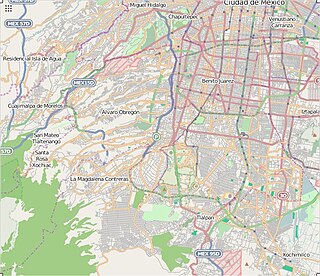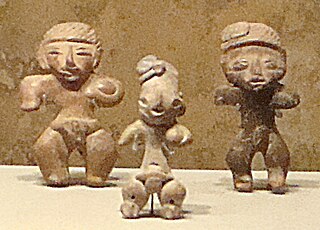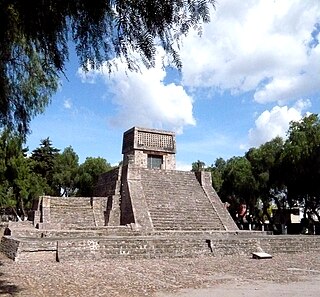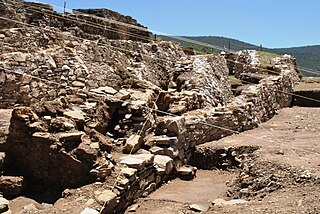This article relies largely or entirely on a single source .(October 2019) |

Mixcoac from Nahuatl means "viper in the cloud" is an archaeological zone belonging to the Mexica (Aztec) culture. It was on the shores of Lake Texcoco and in its final stage was under the rule of Tenochtitlan. With the arrival of the Spanish conquistadors, the settlement was practically destroyed to its foundations, which are the only thing that survives of the architecture of the place and can be appreciated today in what is today the San Pedro de los Pinos neighborhood, on the corner of San Antonio avenue and Periférico, in Mexico City.
Nahuatl, known historically as Aztec, is a language or group of languages of the Uto-Aztecan language family. Varieties of Nahuatl are spoken by about 1.7 million Nahua peoples, most of whom live in central Mexico.

The Mexica (Nahuatl: Mēxihcah, Nahuatl pronunciation: [meːˈʃiʔkaʔ] or Mexicas are a Nahuatl-speaking indigenous people of the Valley of Mexico who were the rulers of the Aztec Empire. This group was also known as the Culhua-Mexica in recognition of its kinship alliance with the neighboring Culhua, descendants of the revered Toltecs, who occupied the Toltec capital of Tula from the tenth through twelfth centuries. The Mexica were additionally referred to as the "Tenochca", a term associated with the name of their altepetl, Tenochtitlan, and Tenochtitlan's founding leader, Tenoch. The Mexica established Mexico Tenochtitlan, a settlement on an island in Lake Texcoco. A dissident group in Mexico-Tenochtitlan separated and founded the settlement of Mexico-Tlatelolco with its own dynastic lineage. The name Aztec was coined by Alexander von Humboldt who combined "Aztlan", their mythic homeland, and "tec ", 'people of'. The term Aztec is often used very broadly to refer not only to the Mexica, but also to the Nahuatl-speaking peoples or Nahuas of the Valley of Mexico and neighboring valleys.

Lake Texcoco was a natural lake within the "Anahuac" or Valley of Mexico. Lake Texcoco is best known as where the Aztecs built the city of Tenochtitlan, which was located on an island within the lake. After the Spanish conquest of the Aztec Empire, efforts to control flooding by the Spanish led to most of the lake being drained. The entire lake basin is now almost completely occupied by Mexico City, the capital of the present-day nation of Mexico.
Contents
The name Mixcoac, viper of the cloud, could be understood as a representation of the celestial serpent or Milky Way. The occupation of this archaeological area is estimated to have occurred from 900 BC to 1521 AD.

Snakes are elongated, legless, carnivorous reptiles of the suborder Serpentes. Like all other squamates, snakes are ectothermic, amniote vertebrates covered in overlapping scales. Many species of snakes have skulls with several more joints than their lizard ancestors, enabling them to swallow prey much larger than their heads with their highly mobile jaws. To accommodate their narrow bodies, snakes' paired organs appear one in front of the other instead of side by side, and most have only one functional lung. Some species retain a pelvic girdle with a pair of vestigial claws on either side of the cloaca. Lizards have evolved elongate bodies without limbs or with greatly reduced limbs about twenty-five times independently via convergent evolution, leading to many lineages of legless lizards. Legless lizards resemble snakes, but several common groups of legless lizards have eyelids and external ears, which snakes lack, although this rule is not universal.

The Milky Way is the galaxy that contains our Solar System, with the name describing the galaxy's appearance from Earth: a hazy band of light seen in the night sky formed from stars that cannot be individually distinguished by the naked eye. The term Milky Way is a translation of the Latin via lactea, from the Greek γαλαξίας κύκλος. From Earth, the Milky Way appears as a band because its disk-shaped structure is viewed from within. Galileo Galilei first resolved the band of light into individual stars with his telescope in 1610. Until the early 1920s, most astronomers thought that the Milky Way contained all the stars in the Universe. Following the 1920 Great Debate between the astronomers Harlow Shapley and Heber Curtis, observations by Edwin Hubble showed that the Milky Way is just one of many galaxies.





















